key MITSUBISHI LANCER SE AWC 2014 8.G Owners Manual
[x] Cancel search | Manufacturer: MITSUBISHI, Model Year: 2014, Model line: LANCER SE AWC, Model: MITSUBISHI LANCER SE AWC 2014 8.GPages: 434, PDF Size: 57.5 MB
Page 11 of 434
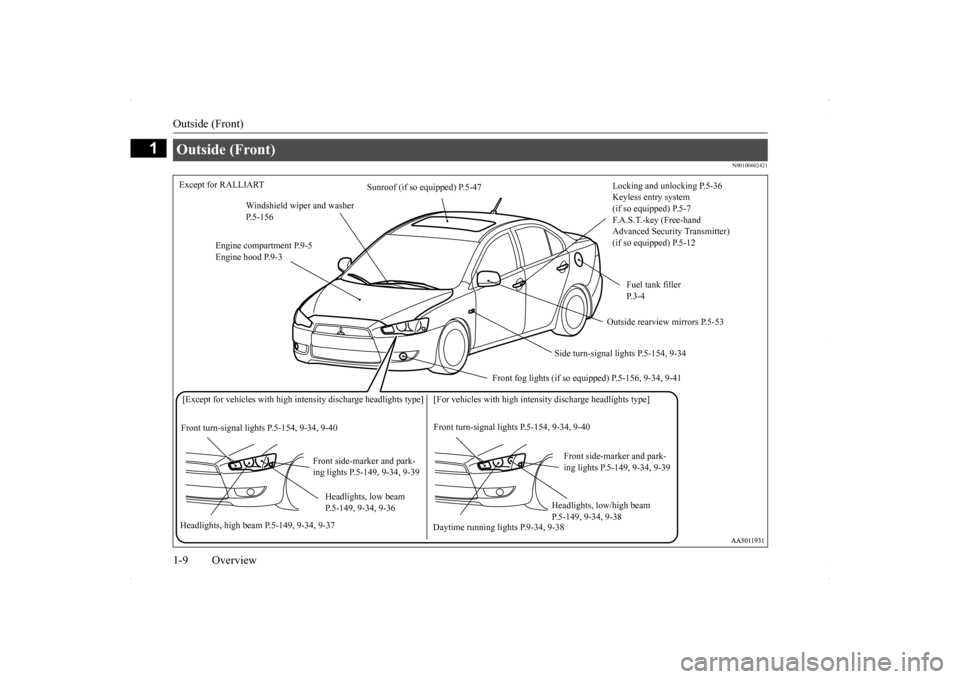
Outside (Front) 1-9 Overview
1
N00100602421
Outside (Front)
Locking and unlocking P.5-36 Keyless entry system (if so equipped) P.5-7 F.A.S.T.-key (Free-hand Advanced Security Transmitter) (if so equipped) P.5-12
Except for RALLIART
Sunroof (if so equipped) P.5-47
Windshield wiper and washer P.5-156
Engine compartment P.9-5 Engine hood P.9-3
Fuel tank filler P.3-4
Outside rearview mirrors P.5-53
Side turn-signal lights P.5-154, 9-34
Front fog lights (if so eq
uipped) P.5-156, 9-34, 9-41
[Except for vehicles with high intensity
discharge headlights type] [For vehicles with
high intensity discharge headlights type]
Front turn-signal light
s P.5-154, 9-34, 9-40
Front turn-signal light
s P.5-154, 9-34, 9-40
Front side-marker and park- ing lights P.5-149, 9-34, 9-39
Front side-marker and park- ing lights P.5-149, 9-34, 9-39
Headlights, low beam P.5-149, 9-34, 9-36
Headlights, low/high beam P.5-149, 9-34, 9-38
Headlights, high beam P.5-149, 9-34, 9-37
Daytime running li
ghts P.9-34, 9-38
Page 12 of 434
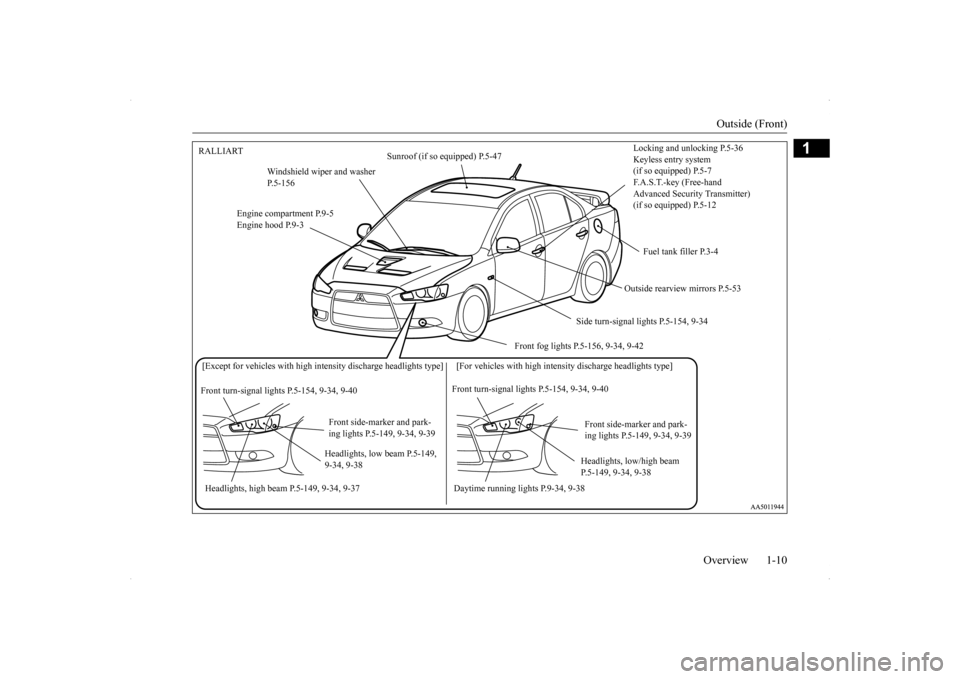
Outside (Front)
Overview 1-10
1
Locking and unlocking P.5-36 Keyless entry system(if so equipped) P.5-7 F.A.S.T.-key (Free-hand Advanced Security Transmitter)(if so equipped) P.5-12
RALLIART
Sunroof (if so equipped) P.5-47
Windshield wiper and washer P.5-156
Engine compartment P.9-5 Engine hood P.9-3
Fuel tank filler P.3-4
Outside rearview mirrors P.5-53
Side turn-signal lights P.5-154, 9-34
Front fog lights P.5-156, 9-34, 9-42
[Except for vehicles with high intensity di
scharge headlights type] [For
vehicles with high intensity discharge headlights type]
Front turn-signal light
s P.5-154, 9-34, 9-40
Front turn-signal light
s P.5-154, 9-34, 9-40
Front side-marker and park- ing lights P.5-149, 9-34, 9-39
Front side-marker and park- ing lights P.5-149, 9-34, 9-39
Headlights, low beam P.5-149, 9-34, 9-38
Headlights, low/high beam P.5-149, 9-34, 9-38
Headlights, high beam P.5-149, 9-34,
9-37 Daytime running lights P.9-34, 9-38
Page 18 of 434
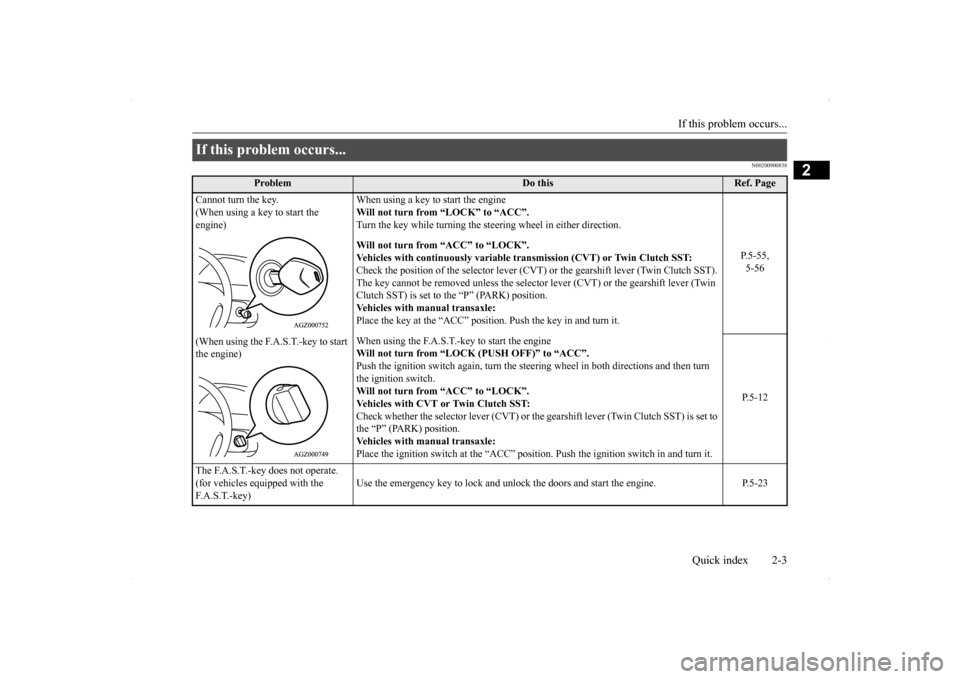
If this problem occurs...
Quick index 2-3
2
N00200900838
If this problem occurs...
Problem
Do this
Ref. Page
Cannot turn the key. (When using a key to start the engine)
When using a key to start the engine Will not turn from “LOCK” to “ACC”. Turn the key while turning the steering wheel in either direction.
P.5-55, 5-56
Will not turn from “ACC” to “LOCK”. Vehicles with continuously variable tr
ansmission (CVT) or Twin Clutch SST:
Check the position of the selector lever (CVT)
or the gearshift lever (Twin Clutch SST).
The key cannot be removed unless the selector lever (CVT) or the gearshift lever (Twin Clutch SST) is set to the “P” (PARK) position.Vehicles with manual transaxle:Place the key at the “ACC” position. Push the key in and turn it.
(When using the F.A.S.T.-key to start the engine)
When using the F.A.S.T.-key to start the engine Will not turn from “LOCK (PUSH OFF)” to “ACC”. Push the ignition switch again, turn the steeri
ng wheel in both directions and then turn
the ignition switch. Will not turn from “ACC” to “LOCK”. Vehicles with CVT or Twin Clutch SST:Check whether the selector lever (CVT) or the gearshift lever (Twin Clutch SST) is set to the “P” (PARK) position. Vehicles with manual transaxle:Place the ignition switch at the “ACC” positi
on. Push the ignition switch in and turn it.
P.5-12
The F.A.S.T.-key does not operate. (for vehicles equipped with the F.A.S.T.-key)
Use the emergency key to lock and unlock the doors and start the engine. P.5-23
Page 19 of 434
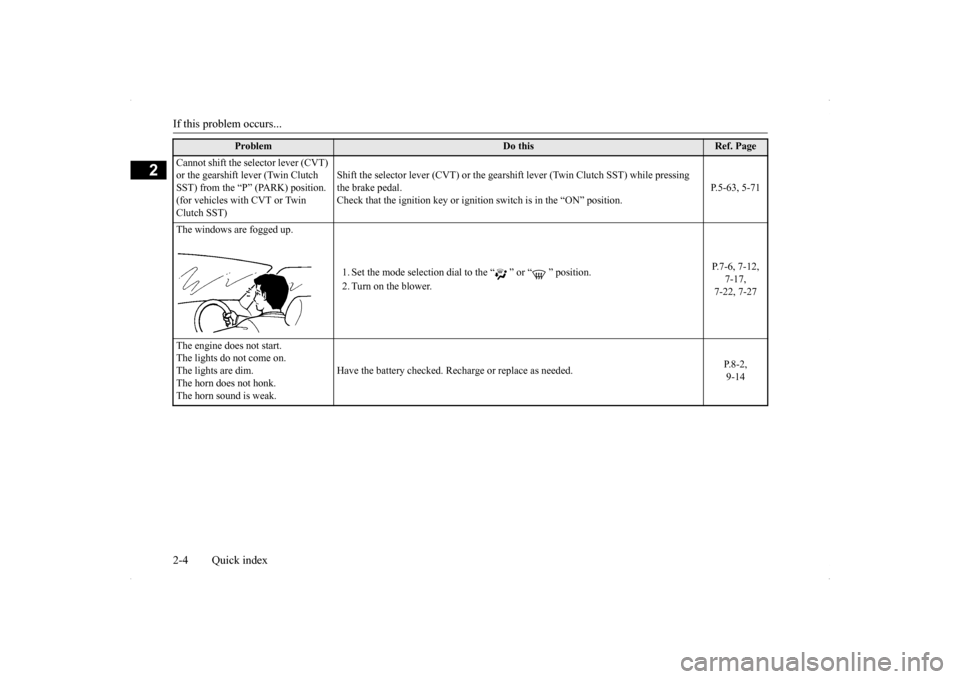
If this problem occurs... 2-4 Quick index
2
Cannot shift the selector lever (CVT) or the gearshift lever (Twin Clutch SST) from the “P” (PARK) position. (for vehicles with CVT or Twin Clutch SST)
Shift the selector lever (CVT) or the gearsh
ift lever (Twin Clutch SST) while pressing
the brake pedal.Check that the ignition key or igniti
on switch is in the “ON” position.
P.5-63, 5-71
The windows are fogged up.
1. Set the mode selection dial to the “ ” or “ ” position. 2. Turn on the blower.
P.7-6, 7-12,
7-17, 7-22, 7-27
The engine does not start. The lights do not come on. The lights are dim. The horn does not honk.The horn sound is weak.
Have the battery checked. Recharge or replace as needed.
P.8-2, 9-14
Problem
Do this
Ref. Page
Page 41 of 434
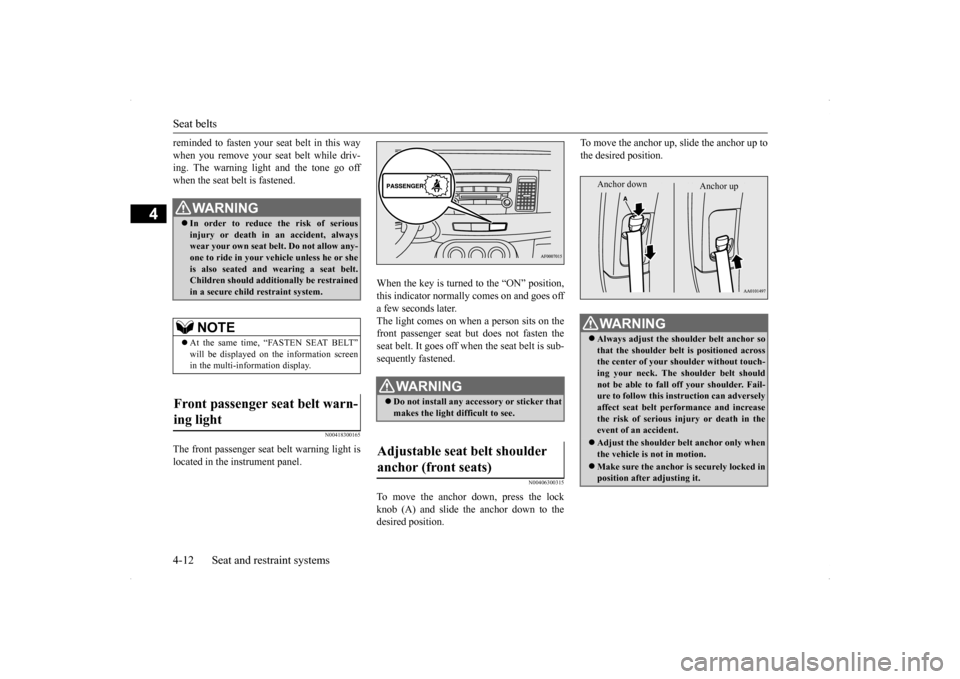
Seat belts 4-12 Seat and restraint systems
4
reminded to fasten your seat belt in this way when you remove your seat belt while driv- ing. The warning light and the tone go off when the seat belt is fastened.
N00418300165
The front passenger seat belt warning light islocated in the instrument panel.
When the key is turned to the “ON” position, this indicator normally comes on and goes offa few seconds later. The light comes on when a person sits on the front passenger seat but does not fasten theseat belt. It goes off when the seat belt is sub- sequently fastened.
N00406300315
To move the anchor
down, press the lock
knob (A) and slide the anchor down to the desired position.
To move the anchor up, slide the anchor up to the desired position.
WA R N I N G In order to reduce the risk of serious injury or death in an accident, alwayswear your own seat belt. Do not allow any- one to ride in your vehicle unless he or she is also seated and wearing a seat belt.Children should additionally be restrained in a secure child restraint system.NOTE
At the same time, “FASTEN SEAT BELT” will be displayed on the information screen in the multi-information display.
Front passenger seat belt warn- ing light
WA R N I N G Do not install any accessory or sticker that makes the light difficult to see.
Adjustable seat belt shoulder anchor (front seats)
WA R N I N G Always adjust the shoulder belt anchor so that the shoulder belt is positioned acrossthe center of your shoulder without touch- ing your neck. The shoulder belt should not be able to fall off your shoulder. Fail-ure to follow this instruction can adversely affect seat belt performance and increase the risk of serious injury or death in theevent of an accident. Adjust the shoulder belt anchor only when the vehicle is not in motion. Make sure the anchor is securely locked in position after adjusting it.Anchor down
Anchor up
Page 50 of 434
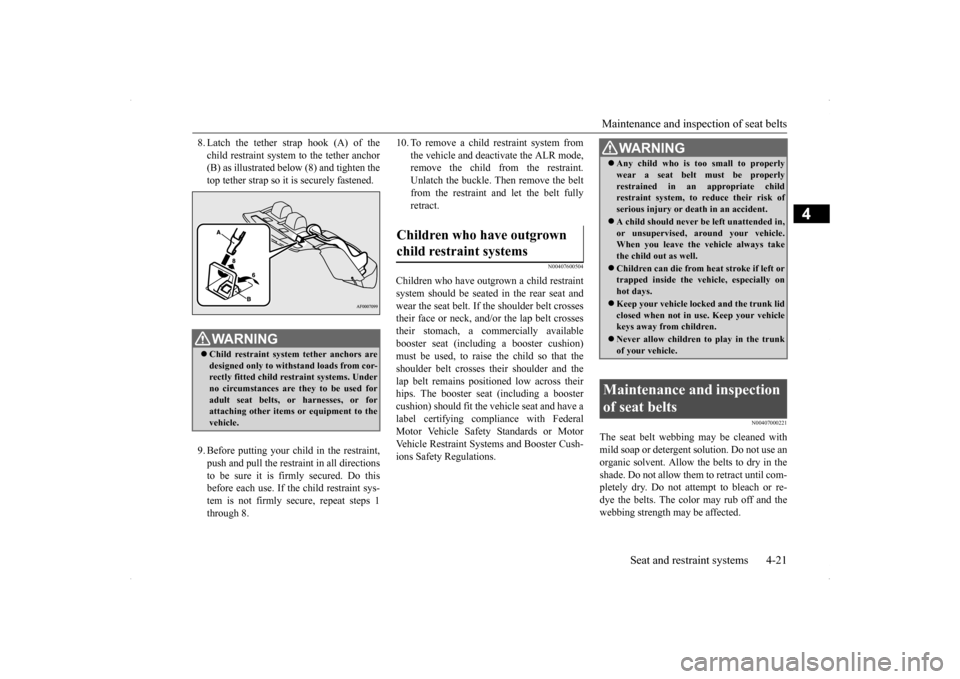
Maintenance and inspection of seat belts
Seat and restraint systems 4-21
4
8. Latch the tether strap hook (A) of the child restraint system to the tether anchor (B) as illustrated below (8) and tighten the top tether strap so it is securely fastened. 9. Before putting your child in the restraint, push and pull the restraint in all directions to be sure it is firmly secured. Do this before each use. If the child restraint sys-tem is not firmly secure, repeat steps 1 through 8.
10. To remove a child restraint system from
the vehicle and deactivate the ALR mode, remove the child from the restraint. Unlatch the buckle. Then remove the beltfrom the restraint and let the belt fully retract.
N00407600504
Children who have outgrown a child restraintsystem should be seated in the rear seat and wear the seat belt. If the shoulder belt crossestheir face or neck, and/or the lap belt crosses their stomach, a commercially available booster seat (including a booster cushion)must be used, to raise the child so that the shoulder belt crosses their shoulder and the lap belt remains positioned low across theirhips. The booster seat (including a booster cushion) should fit the vehicle seat and have a label certifying compliance with FederalMotor Vehicle Safety Standards or Motor Vehicle Restraint Systems and Booster Cush- ions Safety Regulations.
N00407000221
The seat belt webbing may be cleaned withmild soap or detergent solution. Do not use anorganic solvent. Allow the belts to dry in the shade. Do not allow them to retract until com- pletely dry. Do not attempt to bleach or re-dye the belts. The color may rub off and the webbing strength may be affected.
WA R N I N G Child restraint system tether anchors are designed only to withstand loads from cor-rectly fitted child restraint systems. Under no circumstances are they to be used for adult seat belts, or harnesses, or forattaching other items or equipment to the vehicle.
Children who have outgrown child restraint systems
WA R N I N G Any child who is too small to properly wear a seat belt must be properly restrained in an appropriate child restraint system, to reduce their risk of serious injury or death in an accident. A child should never be left unattended in, or unsupervised, around your vehicle.When you leave the
vehicle always take
the child out as well. Children can die from he
at stroke if left or
trapped inside the vehicle, especially on hot days. Keep your vehicle locked and the trunk lid closed when not in use. Keep your vehiclekeys away from children. Never allow children to play in the trunk of your vehicle.
Maintenance and inspection of seat belts
Page 61 of 434

Supplemental Restraint System (SRS) - airbag 4-32 Seat and restraint systems
4
WA R N I N G Do not attach anything to the steering wheel’s padded cover, such as trim mate- rial, badges, etc. These could strike and injure an occupant if the airbag inflates. Do not set anything on, or attach anything to, the instrument panel above the glove compartment. Such items could strike andinjure an occupant if the airbag inflates. WA R N I N G Do not attach accessories to, or put them in front of, the windshield. They could restrict the airbag inflation, or strike andinjure an occupant, when the airbag inflates.
Do not attach additional keys or accesso- ries (hard, pointed or heavy objects) to the ignition key. Such objects could prevent the driver’s knee airbag from inflating normally or could be propelled to causeserious injury if the airbag inflates. Do not attach accessories to the lower por- tion of the driver’s side instrument panel. Such objects could prevent the driver’s knee airbag from inflating normally orcould be propelled to cause serious injury if the airbag inflates.WA R N I N G Do not attempt to remove, install, disas- semble or repair the SRS airbags.WA R N I N G
Do not place objects, such as packages or pets, between the airbags and the driver or the front passenger. Such objects can adversely affect airbag performance, or cause serious injury or death when theairbag deploys. Immediately after airbag inflation, some parts of the airbag system will be hot. Do not touch them. You could be burned. The airbag system is designed to work only once. After the airbags deploy, they will not work again. They must promptlybe replaced and the entire airbag system must be inspected by an authorized Mit- subishi Motors dealer.WA R N I N G
Page 68 of 434
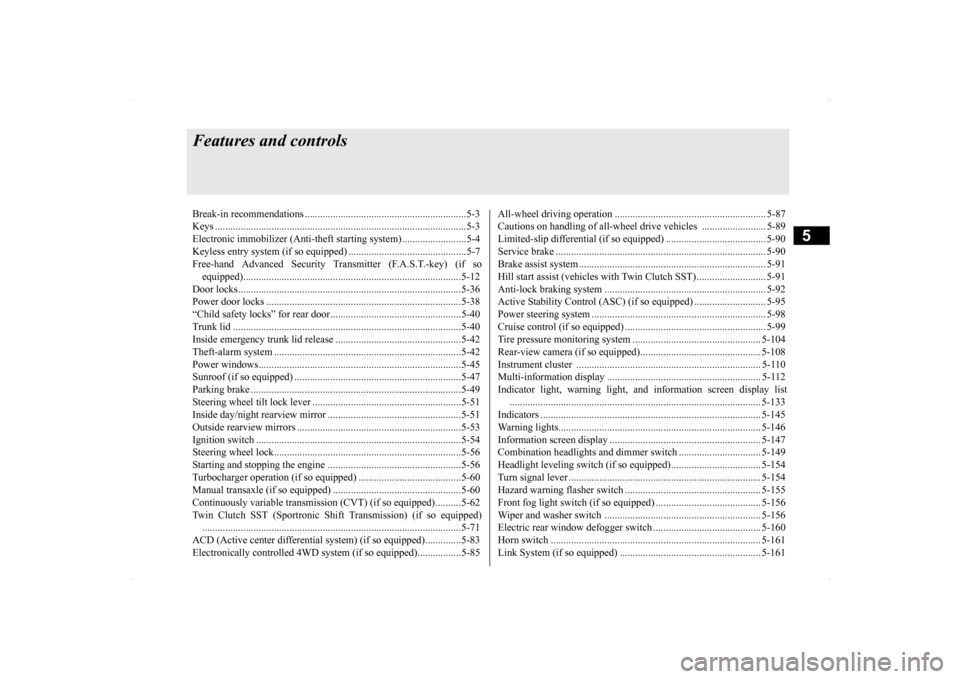
5
Features and controlsBreak-in recommendation
s ...............................................................5-3
Keys .....................................................
.............................................5-3
Electronic immobilizer (Anti-theft starting system) .........................5-4 Keyless entry system (if so equipped) ..............................................5-7Free-hand Advanced Security Transmitter (F.A.S.T.-key) (if so equipped)................................
.....................................................5-12
Door locks........................
...............................................................5-36
Power door locks .............
...............................................................5-38
“Child safety locks” for
rear door...................................................5-40
Trunk lid ....................................
.....................................................5-40
Inside emergency trunk lid
release .................................................5-42
Theft-alarm system ..........
...............................................................5-42
Power windows................
...............................................................5-45
Sunroof (if so equipped
) .........................................
........................5-47
Parking brake ...................
...............................................................5-49
Steering wheel tilt lock lever ..........................................................5-51Inside day/night rearview
mirror ....................................................5-51
Outside rearview mirr
ors ................................................................5-53
Ignition switch .................
...............................................................5-54
Steering wheel lock..........
...............................................................5-56
Starting and stopping the e
ngine ....................................................5-56
Turbocharger operation (if so equipped) ........................................5-60Manual transaxle (if so equipped) ..................................................5-60Continuously variable transmissi
on (CVT) (if so equipped)..........5-62
Twin Clutch SST (Sportronic Shif
t Transmission) (if so equipped)
...................................................................
..................................5-71
ACD (Active center differential system) (if so equipped)..............5-83 Electronically controlled 4WD system (if so equipped).................5-85
All-wheel driving opera
tion ........................................................... 5-87
Cautions on handling of all-wheel drive vehicles ......................... 5-89 Limited-slip differential (i
f so equipped) ....................................... 5-90
Service brake ..................
.................................................
............... 5-90
Brake assist system
................................................
......................... 5-91
Hill start assist (vehicles with
Twin Clutch SST) ........................... 5-91
Anti-lock braking syst
em ......................................
......................... 5-92
Active Stability Control (ASC
) (if so equipped) ............................ 5-95
Power steering system
...........................................
......................... 5-98
Cruise control (if so eq
uipped) ....................................................... 5-99
Tire pressure monitoring
system .................................................. 5-104
Rear-view camera (if so
equipped)..............
................................. 5-108
Instrument cluster ..........
.............................................................. 5-110
Multi-information display ............................................................ 5-112 Indicator light, warning light, and information screen display list
.................................................................
................................. 5-133
Indicators ..................................
.................................................... 5-145
Warning lights.................
.................................................
............. 5-146
Information screen disp
lay ....................................
....................... 5-147
Combination headlights and dimmer switch ................................ 5-149 Headlight leveling switch (if
so equipped)................................... 5-154
Turn signal lever ...
.................................................
....................... 5-154
Hazard warning flasher
switch ..................................................... 5-155
Front fog light switch (if so
equipped) ......................................... 5-156
Wiper and washer swit
ch ......................................
....................... 5-156
Electric rear window def
ogger switch .......................................... 5-160
Horn switch ..............................
.................................................... 5-161
Link System (if so equi
pped) ....................................................... 5-161
Page 70 of 434
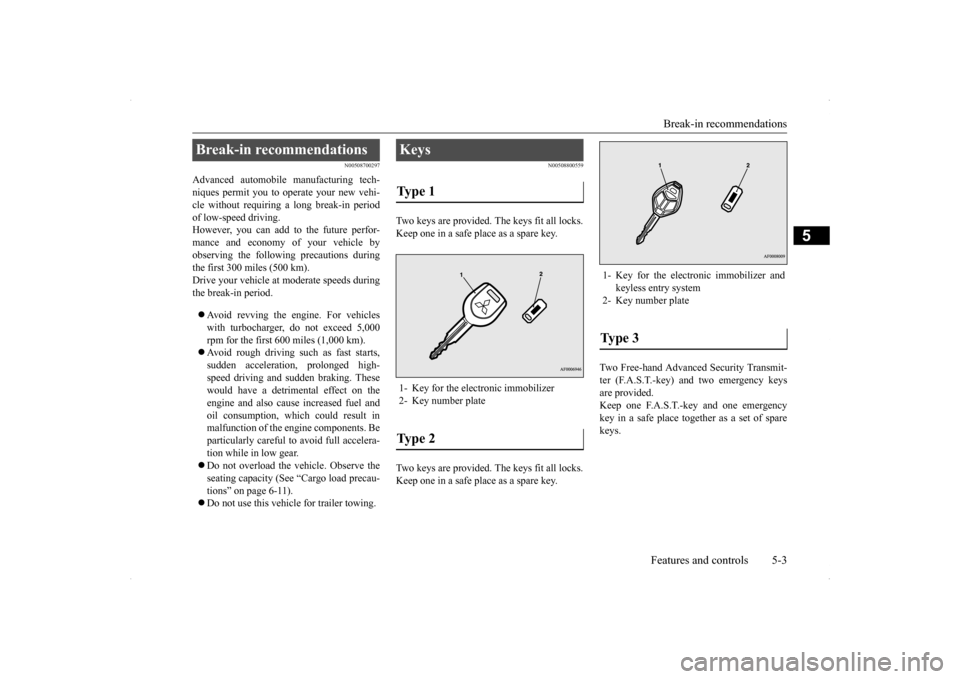
Break-in recommendations
Features and controls 5-3
5
N00508700297
Advanced automobile manufacturing tech- niques permit you to operate your new vehi-cle without requiring a long break-in period of low-speed driving. However, you can add to the future perfor-mance and economy of your vehicle by observing the following precautions during the first 300 miles (500 km).Drive your vehicle at moderate speeds duringthe break-in period. Avoid revving the engine. For vehicles with turbocharger, do not exceed 5,000 rpm for the first 600 miles (1,000 km). Avoid rough driving such as fast starts, sudden acceleration, prolonged high- speed driving and sudden braking. Thesewould have a detrimental effect on the engine and also cause increased fuel and oil consumption, which could result inmalfunction of the engine components. Be particularly careful to avoid full accelera- tion while in low gear. Do not overload the vehicle. Observe the seating capacity (See “Cargo load precau- tions” on page 6-11). Do not use this vehicle for trailer towing.
N00508800559
Two keys are provided. The keys fit all locks. Keep one in a safe place as a spare key. Two keys are provided. The keys fit all locks. Keep one in a safe place as a spare key.
Two Free-hand Advanced Security Transmit- ter (F.A.S.T.-key) and two emergency keysare provided. Keep one F.A.S.T.-key and one emergency key in a safe place together as a set of sparekeys.
Break-in recommendations
Keys Type 1 1- Key for the electronic immobilizer2- Key number plateType 2
1- Key for the electronic immobilizer and
keyless entry system
2- Key number plateType 3
Page 71 of 434
![MITSUBISHI LANCER SE AWC 2014 8.G Owners Manual Electronic immobilizer (Anti-theft starting system) 5-4 Features and controls
5
N00509101804
[For vehicles equipped with the Free-hand Advanced Security Transmitter (F.A.S.T.-key)] For information on MITSUBISHI LANCER SE AWC 2014 8.G Owners Manual Electronic immobilizer (Anti-theft starting system) 5-4 Features and controls
5
N00509101804
[For vehicles equipped with the Free-hand Advanced Security Transmitter (F.A.S.T.-key)] For information on](/img/19/7497/w960_7497-70.png)
Electronic immobilizer (Anti-theft starting system) 5-4 Features and controls
5
N00509101804
[For vehicles equipped with the Free-hand Advanced Security Transmitter (F.A.S.T.-key)] For information on operations for vehicles equipped with the Free-hand Advanced Secu-rity Transmitter (F.A.S.T.-key), refer to “Free-hand Advanced Security Transmitter (F.A.S.T.-key)”: “Electronic immobilizer(Anti-theft starting system)” on page 5-28. [Except for vehicles equipped with the Free- hand Advanced Security Transmitter (F.A.S.T.-key)] The electronic immobilizer is designed to sig-nificantly reduce the possibility of vehicle theft. The purpose of the system is to immo- bilize the vehicle if an invalid start isattempted. A valid start attempt can only be achieved (subject to certain conditions) using a key “registered” to the immobilizer system.All of the keys provided with your new vehi- cle have been programmed to the vehicle’s electronics.
1- Free-hand Advanced Security Transmit-
ter (F.A.S.T.-key) (with electronic immo
bilizer and keyless
entry system function)
2- Emergency key 3- Key number plate
NOTE
The key is a precision electronic device with a built-in signal transmitter. Please observethe following in order to prevent damage. • Do not leave where it may be exposed to heat caused by direct sunlight, such as on top of the dashboard. • Do not take the remote control transmitter apart. • Do not excessively bend the key or subject it to strong impacts. • Keep the remote control transmitter dry. • Keep away from magnetic objects such as key holders.
• Keep away from devices that produce mag- netism, such as audio systems, computers and televisions. • Keep away from devices that emit strong electromagnetic waves, such as cellular phones, wireless devices and high fre- quency equipment (including medicaldevices). • Do not clean with ultrasonic cleaners.• Do not leave the key where it may be exposed to high temperature or high humid-ity.
If you lose your key, to prevent the theft of the vehicle immediately contact an autho- rized Mitsubishi Motors dealer. If you notify an authorized MitsubishiMotors dealer of the key number, they can make a new key. The key number is stamped on the key number plate. Keep the key num-ber plate in a safe place separate from the key itself. No keys other than those registered in advance can be used to start the engine. Refer to “Electronic immobilizer (Anti-theftstarting system)” on page 5-4. Refer to “Free-hand Advanced Security Transmitter (F.A.S.T.-key)”: “Electronic immobilizer (Anti-theft starting system)” on page 5-28.NOTE
Electronic immobilizer (Anti-theft starting system)